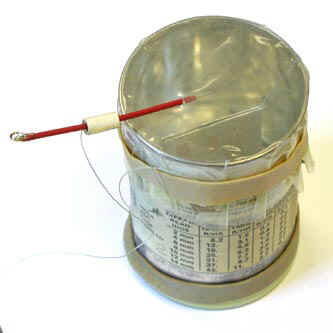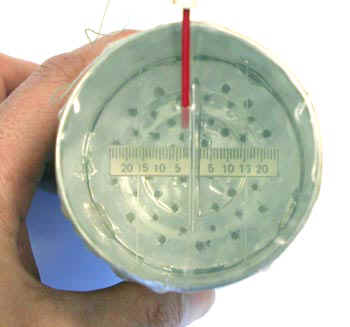Kearny Fallout Meter (1970s)

Developed by Cresson Kearny at Oak Ridge National Laboratory, the Kearny Fallout Meter (KFM) is a civil defense instrument that can be built in a few hours from readily available materials: a soup can, aluminum foil, thread, plastic, wire, bits of drywall, and tape. The only tools required are a pair of scissors, a hammer and a nail. Despite its simplicity, it is said to be able to measure exposure rates from 30 mR/hr to 43 R/hr with an accuracy of plus or minus 25%.
The KFM is actually an aluminum foil electroscope, the body of which is made from a soup can (ca. 2 5/8” in diameter and 4” high). Some type of desiccant (e.g., heated gypsum from drywall) is stored in the bottom. In this particular design, the desiccant is covered with a perforated metal disk (the top of the can with holes punched it). A paper scale, ca. 10 mm x 50 mm, is glued to the perforated disk so that it can be viewed by looking down through the top of the can. In later versions of the KFM, the scale is attached to the clear plastic sheet stretched across the top of the can, and the perforated metal disk covering the desiccant is done away with. Two aluminum leaves (1.5” x 1 Ľ”) are suspended above the scale from parallel nylon threads attached to the top of the can. The leaves, made from eight-ply aluminum foil, are charged via a 3” insulated “charging wire,” bare at each end, that penetrates the plastic sheet. The charge itself is created by rapidly unwinding a piece of scotch tape.

After being charged, the leaves separate and the spacing (in mm) of the bottom edges of the leaves on the scale is noted. After the exposure (15 seconds to 1 hour), when the leaves have moved closer together, the spacing of the leaf edges is noted once more. The decrease in the spacing is converted to the exposure by referring to the calibration table taped to the side of the can.
The calibration table, as well as templates and instructions for the meter’s construction, can be found in “The KFM, A Homemade Yet Accurate and Dependable Fallout Meter.”
Kearny’s KFM can be considered an improved version of a home-made electroscope described by Callahan and Kaplan in 1960. Kearny identified the following advantages of his KFM over Callahan and Kaplan’s electroscope:
- Its maximum measurable exposure (full discharge) was 200 mR vs 5 mR.
- It could operate under humid conditions.
- It was easier to construct.
Donated by the Federal Emergency Management Agency courtesy of Carl Siebentritt.
References
Callahan, E.D. and Kaplan, A.L. “The Electroscope – A Home-made Radiation Detection Instrument for Home Use.” TO-B-60-21 prepared for OCDM. (May 15, 1960).
Kearny, C.H. et al. “The KFM, A Homemade yet Accurate and Dependable Fallout Meter” ORNL-5040 (corrected). (January 1978).
